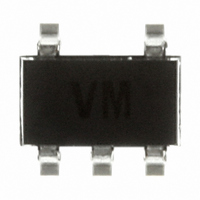TSC101BILT STMicroelectronics, TSC101BILT Datasheet

TSC101BILT
Specifications of TSC101BILT
TSC101BILT
Available stocks
Related parts for TSC101BILT
TSC101BILT Summary of contents
Page 1
Features ■ Independent supply and input common-mode voltages ■ Wide common-mode operating range: 2.8 to 30V ■ Wide common-mode surviving range: -0.3 to 60V (load-dump) ■ Wide supply voltage range 24V ■ Low current consumption: I ■ Internally ...
Page 2
Application schematics and pin description 1 Application schematics and pin description The TSC101 high-side current-sense amplifier features a 2.8V to 30V input common-mode range that is independent of supply voltage. The main advantage of this feature is to allow high-side ...
Page 3
TSC101 2 Absolute maximum ratings and operating conditions Table 2. Absolute maximum ratings Symbol V Input pins differential voltage ( Input pin voltages ( supply voltage output pin voltage out T Storage ...
Page 4
Electrical characteristics 3 Electrical characteristics (1) Table 4. Supply Symbol Parameter I Total supply current CC 1. Unless otherwise specified, the test conditions are T (1) Table 5. Input Symbol Parameter Common mode rejection CMR Variation of V versus V ...
Page 5
TSC101 (1) Table 6. Output Symbol Parameter Av Gain ΔAv Gain accuracy ΔV /ΔT Output voltage drift vs. T out ΔV /ΔI Output stage load regulation out out ΔV Total output voltage accuracy out ΔV Total output voltage accuracy out ...
Page 6
Electrical characteristics Table 7. Frequency response Symbol Parameter ts Output settling to 1% final value SR Slew rate BW 3dB bandwidth 1. Unless otherwise specified, the test conditions are T (1) Table 8. Noise Symbol Parameter Total output voltage noise ...
Page 7
TSC101 Figure 2. Supply current vs. supply voltage (V = 0V) sense 260 240 220 T=25°C 200 180 160 140 120 100 (V) CC Figure 4. V pin input bias current vs ...
Page 8
Electrical characteristics Figure 7. Output stage low-state saturation voltage versus output current (V = -1V) sense 400 output stage 350 sourcing current 300 250 200 T=25°C 150 100 -50 I (mA) out Figure 9. Output ...
Page 9
TSC101 Figure 12. Input offset drift versus temperature 300 200 100 0 -50 - -100 -200 -300 -400 -500 T (°C) Figure 14. Bode diagram ( TSC101C 10 TSC101B 0 TSC101A -10 -20 ...
Page 10
Electrical characteristics Figure 17. Output voltage versus TSC101B 2 TSC101C 0 -100 0 100 200 300 V (mV) sense Figure 19. Step response TSC101C TSC101B TSC101A 10/17 Figure 18. Output voltage versus V sense ...
Page 11
TSC101 4 Parameter definitions Common mode rejection ratio (CMR) The common-mode rejection ratio (CMR) measures the ability of the current-sensing amplifier to reject any DC voltage applied on both inputs V back to the input so that its effect can ...
Page 12
Parameter definitions Figure 20. V out Output voltage drift versus temperature The output voltage drift versus temperature is defined as the maximum variation of V respect to its value at 25°C, over the temperature range calculated as follows: ...
Page 13
TSC101 Output voltage accuracy The output voltage accuracy is the difference between the actual output voltage and the theoretical output voltage. Ideally, the current sensing output voltage should be equal to the input differential voltage multiplied by the theoretical gain, ...
Page 14
Application information 5 Application information The TSC101 can be used to measure current and to feed back the information to a microcontroller, as shown in Figure 23. Typical application schematic 2.8V to 30V Rg3 Gnd The current from the supply ...
Page 15
... JEDEC Standard JESD97. The maximum ratings related to soldering conditions are also marked on the inner box label. ECOPACK is an STMicroelectronics trademark. ECOPACK specifications are available at: www.st.com. Figure 24. SOT23-5 package Ref ...
Page 16
... Ordering information 7 Ordering information Table 9. Order codes Temperature Part number range TSC101AILT TSC101BILT -40°C, +125°C TSC101CILT (1) TSC101AIYLT (1) TSC101BIYLT -40°C, +125°C (1) TSC101CIYLT 1. Qualification and characterization according to AEC Q100 and Q003 or equivalent, advanced screening according to AEC Q001 & Q 002 or equivalent are on-going. ...
Page 17
... TSC101 Information in this document is provided solely in connection with ST products. STMicroelectronics NV and its subsidiaries (“ST”) reserve the right to make changes, corrections, modifications or improvements, to this document, and the products and services described herein at any time, without notice. All ST products are sold pursuant to ST’s terms and conditions of sale. ...














